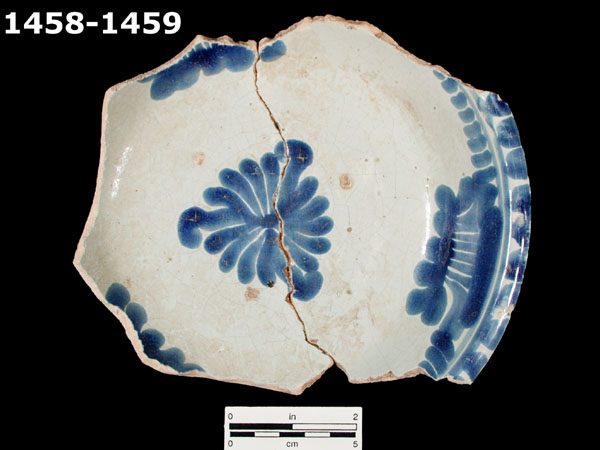View all examples of PUEBLA BLUE ON WHITE

| Type Name: | PUEBLA BLUE ON WHITE |
| Type Index: | MAJOLICA |
| Production Origin: | PUEBLA , MEXICO |
| Date Range: | 1675-1800 |
| Defining Attributes: |
Creamy white to pale peach or buff paste with little visible temper. Cream to off-white, glossy background enamel, often with light crazing. Decorations are painted in one or two shades of cobalt blue. Designs are commonly composed using dots, bands and lobe shapes. Motifs include stylized floral and zoomorphic elements, as well as geometric patterns. Fino (fine grade) Puebla blue on white has a whiter background color, and precisely painted, often complex designs covering much of the vessel surface. Fino vessels often have overlapping blue arcs on their reverse. Entrefino (common grade) Puebla Blue on white has an off-white background color, and casually executed designs consisting of rim bands with pendant elements along with a central medallion floral or animal design. |
| Vessel Forms: |
BOWL CUP FIGURINE INKWELL JAR LEBRILLO PLATE POCILLO TILE VASE |
| Comments: | Puebla Blue on White is the most commonly found majolica in 18th century Spanish-American archaeological sites. The type encompasses a very wide range of variation in its designs and its execution, which can include fino (fine grade) and entrefino (common grade) categories. The fino Puebla Blue on White category, defined by Lister and Lister (1974, 1983), overlaps the type, San Agustín Blue on White (Goggon 1968; Deagan 2002). Design motifs on fino and entrefino vessels are highly varied, and made a gradual transition through the 18th century from predominantly Chinese and Talaveran-inspired motifs, to motifs based on English refined earthenware decoration. These later examples are often molded, with fluted or scalloped rims, and have decoration emphasizing the rim band (See "Puebla Blue on White, Late") |
| Published Definitions: | Deagan 2002; Goggin 1968; Lister and Lister 1974,1983 |